![]()
Simple Way to Run RV Fridge on Propane!
DISCLAIMER: AS AN AMAZON ASSOCIATE I EARN FROM QUALIFYING PURCHASES. THIS POST CONTAINS AFFILIATE LINKS THAT WILL REWARD ME MONETARILY OR OTHERWISE WHEN YOU USE THEM TO MAKE QUALIFYING PURCHASES. FOR MORE INFORMATION, PLEASE READ MY EARNINGS DISCLAIMER.
|
Running an LP (or Liquid Propane) refrigerator is as simple as turning ON the propane tank! Allow a minute for the gas to start flowing and then just push the power button! After that, set it to the highest temperature setting on the control panel and select “gas” as your running mode.
Also, make sure your house batteries are not depleted, since you will need electricity to open the gas valve and light the igniter. The refrigerator will only work if the deep cycle battery (or battery bank) has adequate juice or shore power is connected. You can also run your propane fridge on the generator.
The operation of the refrigerator in an RV varies depending on its type and it is always important to consult the owner’s manual first! Here are some general instructions on how to run your fridge on propane gas:
- Step 1. Level your RV. Your RV must be perfectly leveled for the propane refrigerator to work.
- Step 2. Get some electricity. To work, the refrigerator control requires 12 volts of DC power. Plugin your refrigerator into an electrical circuit and make sure that you have juice in your batteries if that is what is powering your RV at the moment. If your battery has an OFF switch, turn it ON!
- Step 3. Turn ON the gas valve. You’ll need to make sure that the LP gas tank’s valve is switched ON.
- Step 4. Find the control panel. When you’re ready to start using propane to power your refrigerator, you’ll need to find the control panel. Here are some examples of control panels:

It will generally have ON and OFF buttons and a switch (or button) to set it to propane. It is also possible that your refrigerator will have a small screen and a button where these settings can be adjusted.
Control Panel
The Control panel is usually located between the fresh food and freezer chambers of your refrigerator or above the freezer compartment (check your user’s manual for the exact location). Common buttons of the control panel include:
- Power button. This button switches ON and OFF the refrigerator.
- Mode button. Pressing and holding this button alternates between AUTO, manual GAS, manual 12v DC (Direct Current), and manual 120v AC (or Alternating Current) mode settings. This varies on the type of refrigerator used. Your last chosen mode will be displayed for 5 seconds after releasing the push button.
- Temperature button. By pressing and holding this button, you can cycle between the temperature settings from 1 to 5, with 5 being the coolest. This varies from manufacture to manufacturer, but you get the idea… When you release the pushbutton, the last temperature setting selected will be displayed for 5 seconds.
In three-way refrigerators, the “AUTO” mode of the control panel automatically selects the best available energy source. When a more energy-efficient energy source becomes available, the refrigerator switches to it automatically (and AC energy is believed to be the more efficient energy source).
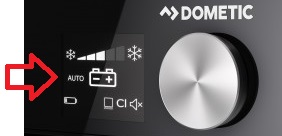
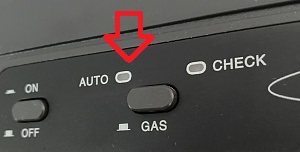
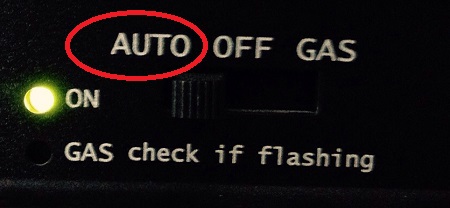
If the control’s first choice (AC power) is not available, propane gas will be used as a backup option. If you want to run on propane gas all the time, do not select the “AUTO” option.
- Step 5. Set up your temperature. To begin, set the thermostat to the highest possible setting (which is commonly #5).
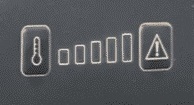
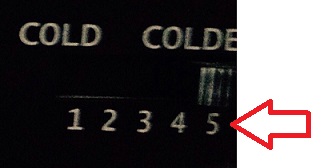
- Step 6. Select your propane setting. After you selected your temperature, push a button or move a switch to the refrigerator’s “propane mode”. It could also look like a flame icon:
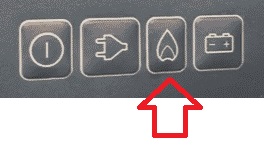
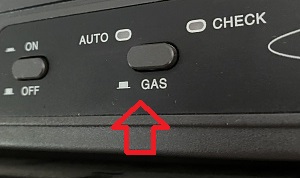
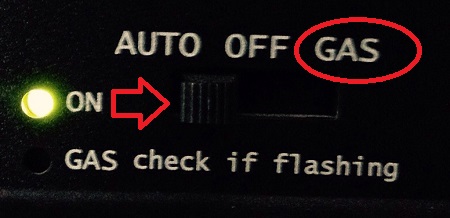
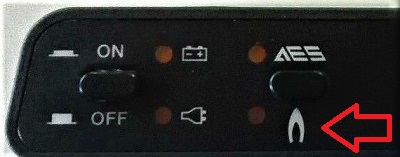
After you select “GAS”, the refrigerator control initiates a 40-second trial ignites when converting to gas operation. The control opens the gas safety valve and starts sparking the burner.
If the control does not detect the presence of a flame after 40 seconds, the gas safety valve closes down, and sparking stops. The indicator will tell you that the burner failed to ignite.
Turning the refrigerator OFF and ON again will reset the indicator and a new 40-second trial ignition cycle will begin.
Very often your refrigerator will require two or three ignition tries before properly igniting the burner. It usually happens on the very first start-up or after changing a propane tank.
It’s possible that you’ll need to purge the propane system of air if you’re having trouble getting the flame to light. If the burner fails to ignite after many attempts, consult a specialist or your local authorized service dealer.
- Step 7. Adjust the refrigerator to the desired temperature. You can use a thermostat to control the temperature of your RV fridge once the pilot is lit. It should now be totally propane-powered!
- Step 8. Give it some time. It will take about 12 to 24 hours to cool down the refrigerator to the temperature you specified. The best idea is to start your refrigerator the day before you plan to fill it.
- Step 9. Use your refrigerator! Don’t we all love (or need) to eat? And what can be better than traveling across the country, visiting unbelievable places, and having your favorite meals along the way!
** Important note. These are general instructions. Consult your owner’s manual for more details and specific information about your refrigerator model. If your manual is missing, check out this list of manuals (external link).
The video below is a good explanation of how to use an RV propane refrigerator:
A remarkable amount of freedom is offered by a propane-powered refrigerator! Here are its primary benefits:
- You can easily go boondocking without a huge battery bank and your food will be protected.
- A propane-powered refrigerator has no moving parts, which means fewer problems. It is not uncommon to see a propane refrigerator that is 30+ years in age.
- A refrigerator that runs on propane is less expensive to run than a traditional one. A propane-powered absorption refrigerator can last about two months on a 13 kg tank.
- In a propane refrigerator, only minimum battery power is required for it to work.
Propane (or LP) refrigerators are known for their dependability. They don’t have any moving parts and that’s why friction does not wear them out.
The rust clogging could become a problem after 30 years or so, but even in this case, if you flip your refrigerator upside down, in a couple of hours debris should return to the tank and it will be usable again.
Unfortunately, if this problem occurs again, you will have to replace the refrigerator. Operating a propane-powered refrigerator in an RV might be more cost-effective in comparison to a 12-volt refrigerator. It generally comes down to maintenance.
A propane refrigerator requires almost minimal maintenance and can be cleaned about twice a year (the burner section and the combustion tube). Now, let’s look at how a propane-powered refrigerator works.
How RV propane refrigerator works
In order the get the most out of your refrigerator, you need to know how it works! The refrigeration process is carried out by five key components of propane refrigerators (as propane gas indicates a whole process):
- Generator (or Boiler)
- Separator
- Condenser
- Absorber
- Evaporator
Underneath the generator (also called a boiler) you will find a propane burner and this is how it gets heated. Ammonia and water inside the generator get heated and start to boil.
This boiling solution flows through the pipe to the separator. The separator (as the name states) separates ammonia from the water. How it’s done? Ammonia turns into gas and rises, while the water gets directed to the absorber (where it will be stored until it is needed again).
At the same time, the ammonia is directed to the condenser (which is a large coil that is responsible for dissipating heat and returning ammonia back to its liquid state):
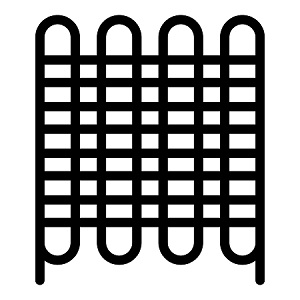
The liquid ammonia then is transported to the evaporator (or freezing unit), where it is mixed with hydrogen gas. This chemical reaction forces ammonia to evaporate as a frozen vapor.
Pressurized ammonia steam now is moving toward the cooling coils and the absorber, where it gets recombined with the water. Ammonia reacts chemically with the water and turns back into a liquid.
The hydrogen gas returns to the evaporator and ammonia with water return back to the generator (or boiler).
Here are some propane-handling tips:
RV propane refrigerator issues
If your refrigerator works on electricity and not on propane gas, the first thing you should do is check to see if the tank is full of gas and if the valve is open. If your RV has this feature, make sure all of the LP alarms are connected and working.
If the propane tank is full, the valve is open, the alarms are operational, and it still doesn’t work the thermocouple must be tested. The thermocouple regulates the flow of gas and detects valve heating.
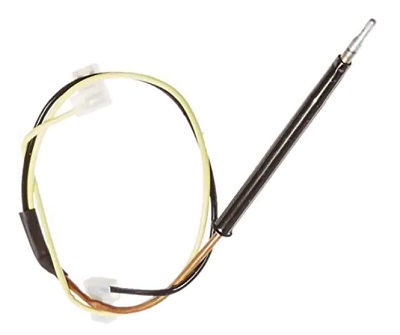
When the burner or pilot light works but doesn’t remain ON (as it should), it’s a symptom of a thermocouple (or flame sensor) problem. If this is the case, replace the thermocouple.
If there is no flame in the burner at all, you may need to restart the refrigerator to check if it turns on. Smell gas? You have a problem with a broken igniter if you hear the valve turn on and smell gas but it does not light.
A thorough cleaning may be necessary to get the refrigerator back on track, particularly if the burner light is out.
If there is debris obstructing the passage of propane to the burner, your gas-powered refrigerator will simply not work!
The clog could be in the gas line or the burner, and you can clean it out quickly using a shop vac. To clean it, remove the metal cover from the burner and vacuum.
A piece of thin wire can be used to clean the burner hole as an alternative. If the flame still won’t catch, you’ll need professional assistance.
Electric igniters should have a visible spark that could also be recognized as a clicking sound.
If there is no clicking sound, then it is highly likely to be an issue with the control board. The gas valve may not be working properly if you hear the ignitor but don’t see any flame.
Hope you enjoyed my article. If you need immediate assistance with your RV, feel free to find a local specialist on this map:

You can also search our database:
Attention! This article is for informational purposes ONLY and is NOT a replacement for professional advice! ALWAYS consult your local specialist for an appropriate solution to your problem. All statements, prices, contact information, recommendations, and reviews contained herein came from sources that we believe to be reliable, but the accuracy or completeness thereof is not guaranteed. Please contact the service provider for complete details and updates.


